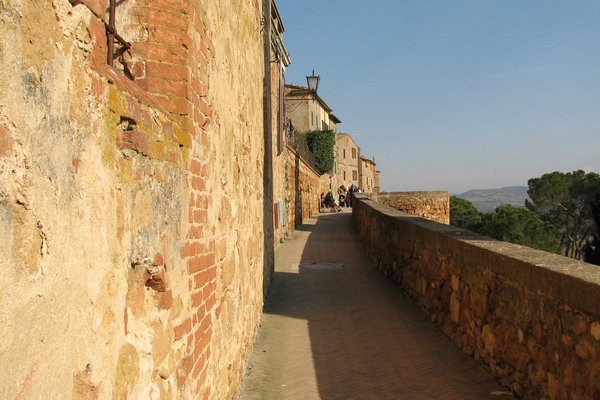Italy
Pienza
The Historic Centre of the City of Pienza is the earliest example of a Renaissance "ideal town".
It was created by Pope Pius II, a humanist who decided to refurbish his poor hometown of Corsignano and turn it into his papal summer court. The buildings and objects designed by Bernardo Rossellino are a blend of the Renaissance and the German Gothic style. Also, the technique of sgraffito was used all over town.
Community Perspective: To most of us, it’s a lovely little town with a homogenous townscape. You have to be a student of architectural history to fully appreciate the Humanist Renaissance influence in its design.
Site Info
Official Information
- Full Name
- Historic Centre of the City of Pienza (ID: 789)
- Country
- Italy
- Status
-
Inscribed 1996
Site history
History of Pienza
- 1996: Inscribed
- Inscribed
- Type
- Cultural
- Criteria
- i
- ii
- iv
Links
- UNESCO
- whc.unesco.org
- Official
-
- discovertuscany.com — Discover Tuscany
- Related
-
- en.wikipedia.org — Biography of Pius II
All Links
UNESCO.org
- whc.unesco.org — whc.unesco.org/
Official Website
- discovertuscany.com — Discover Tuscany
Related Resources
- en.wikipedia.org — Biography of Pius II
Community Information
- Community Category
- Human activity: Urban planning
Travel Information
Exact locations inscribed twice (or more)
Also part of the Val d'Orcia WHS
Recent Connections
-
Cities commanded "Ex nihilo"
1459 Pius II. The small, medieval hamle…
-
Exact locations inscribed twice (or more)
Also part of the Val d'Orcia WHS
-
Perfect Inscriptions
1996
Connections of Pienza
- Individual People
-
-
Frederick II
"Around 1300 parts of the village became property of the Piccolomini family. After Enghelberto d'Ugo Piccolomini had received the fief of Montertari in Val d'Orcia from the emperor Frederick II in 1220." (Wikipedia)See en.wikipedia.org
-
- Geography
-
-
Contiguous National Sites
With Val d'Orcia
-
- Trivia
-
-
Modelled after
Piccolomini Palace: "The influence of Alberti is stronger here, since Rossellino based it on his Rucellai Palace in Florence." (AB Ev)
-
- History
-
-
Popes
Was named after and redesigned by Pope Pius II (Pope between 19 August 1458 - 15 August 1464) -
Cities commanded "Ex nihilo"
1459 Pius II. The small, medieval hamlet of Corsignano. To transform his birthplace into the first Ideal City founded on Humanist principles.
-
- Architecture
-
-
Designed by Leon Battista Alberti
Planned by Bernardo Rossellino, Leon Battista Alberti as consultant -
Sgraffito
"one of the most characteristic elements is the widespread use of sgraffito decoration on the facades, which confers a certain measure of uniformity on the urban fabric of Pienza, and also indicates the desire to endow a city that was the birthplace of a Pope with a new dignity." (AB Ev) -
Ideal City
As the first application of the Renaissance Humanist concept of urban design, the town occupies a seminal position in the development of the concept of the planned "ideal town" and plays a significant role in subsequent urban development in Italy and beyond." (OUV) – "The application of the principle of the Renaissance "ideal city" in Pienza, and in particular in the group of buildings around the central square, resulted in a masterpiece of human creative genius." (OUV – criterion i) -
Italian Renaissance garden
Gardens of the Palazzo Piccolomini -
Carrara marble
Pozzo del Rossellino -
Gothic
"(...) the interior of the Pienza Cathedral, typical of the late Gothic style of southern German churches while the exterior is pure Renaissance. The bell tower blends Gothic and Renaissance forms." (OUV) -
Renaissance
"Renaissance town-planning concepts were first put into practice when Pope Pius II enlisted the architect Bernardo Rossellino to transform his birthplace." - "(...) the interior of the Pienza Cathedral, typical of the late Gothic style of southern German churches while the exterior is pure Renaissance. The bell tower blends Gothic and Renaissance forms." (OUV)
-
- Damaged
-
-
Destroyed or damaged by Earthquake
The bell tower of the Duomo was damaged by the earthquake of 1545 and restored in 1570.See it.wikipedia.org
-
- World Heritage Process
-
-
Perfect Inscriptions
1996 -
Exact locations inscribed twice (or more)
Also part of the Val d'Orcia WHS
-
- Religion and Belief
-
-
Franciscan Order
"San Francesco is a gothic-style, Roman Catholic church (...) founded in the 13th century by Franciscans from the monastery of Corsignano." (Wikipedia)See en.wikipedia.org
-
Cathedrals
Cathedral Santa Maria Assunta (1459-1462), Gothic
-
- Human Activity
-
-
Traditional sports and games
Cacio al fuso - a cheese rolling game
-
- Constructions
-
-
Hospitals
"Two structures with a social function, the hospital and the inn in front of the church of St Francis, were also built on his orders." (AB ev) -
Loggia
Palazzo Piccolomini - Pienza -
Clock Tower
The tower of the Palazzo Comunale, built in terracotta, with long windows and crowned by a double row of battlements. (Wikipedia)See it.wikipedia.org
-
Horse Stables
Below the garden of the Piccolomini Palace "is a vaulted stable that had stalls for 100 horses." (Wikipedia)
-
- WHS on Other Lists
-
-
Most beautiful villages
Pienza is among the Bandiere arancioni ('orange flags') by the Touring Club Italiano.
-
- Timeline
-
-
Built in the 15th century
Major buildings, including cathedral and town hall (1462)
-
- WHS Hotspots
- WHS Names
-
-
Named after individual people
Pope Pius II
-
- Literature & Film
-
-
Location for a classic movie
Scenes set in the palace of the Capulets for the 1968 movie "Romeo and Juliet" by Franco Zeffirelli were shot at Palazzo Piccolomini. Some of the street scenes were also shot in Pienza.See en.wikipedia.org
-
News
No news.
Recent Visitors
Visitors of Pienza
- Afshin Iranpour
- Aitia
- Albert
- Alberto Rodriguez Gutierrez
- Alexander Barabanov
- Alexander Lehmann
- Alex Goh
- Alvaro1404
- Ammon Watkins
- Andrea Szabo
- Argo
- Aspasia
- Astraftis
- Atila Ege
- AustralLights
- AYB
- BaziFettehenne
- Bill Maurmann
- Bin
- Bropyk
- butterflybird
- Cezar Grozavu
- chenboada
- chenqtao
- Cheryl
- ChrisN
- Christravelblog
- Claire Bradshaw
- Cluckily
- Clyde
- Cobaltrage
- Coppi
- Cristina Erba
- Cyberczar
- Daniela Hohmann
- Dan Pettigrew
- David Aaronson
- David Berlanda
- David Marton
- DavidS
- Dimitar Krastev
- Dimitrios Polychronopoulos
- DL
- Dorejd
- Dr. Caligari
- Elia Vettorato
- eljx1988
- Els Slots
- Erik Jelinek
- Errol Neo
- Evgenii
- fabi-ddorf
- Fan Yibo
- Farinelli
- Federico P.
- Flexiear
- Frédéric M
- Frederik Dawson
- George Gdanski
- GeorgeIng61
- GerhardM
- Gernot
- grimloch
- Hadrianus
- HaraldOest
- Harry Mitsidis
- Hasco
- hdimoshi
- Hubert
- Iain Jackson
- Ilya Burlak
- Ivan Rucek
- Jaakkotoivanen
- Jacob Otten
- Jakob F.
- James Bowyer
- Janina Lehmann
- Jarek Pokrzywnicki
- jcleek27
- Jeanne OGrady
- Jens
- Jesse S 2010
- Jezza
- Joel on the Road
- Jonas Hagung
- Jonas Kremer
- Jon Eshuijs
- Joyce van Soest
- Jurre
- KarenBMoore
- Karito Vies
- Ken DJ
- Knut
- Krzysztof B
- La Concy
- Lara Adler
- LaVale
- lindaann
- Lisu Marian
- Loic Pedras
- Luboang
- Luis Filipe Gaspar
- Maciej Gil
- Malgorzata Kopczynska
- Małgosia Łupicka
- marcel staron
- Marinemajor
- Martina Rúčková
- Matejicek
- Mateusz
- Mathijs
- MAURO PODDA PANI
- MaYumin
- MichaelH
- Michael Turtle
- Mikko
- MMM
- Mo-han Je
- Monica Tasciotti
- Morodhi
- Mtlmr
- Naim Y
- nan
- Nasebaer
- Nihal Ege
- NoahFranc
- opperpco3
- PabloNorte
- Patrik
- Paul Schofield
- PeterH
- Peter Lööv
- Petteri
- Philipp Leu
- Philipp Peterer
- phillipmeng
- Piotr Wasil
- Rafał Kałczuga
- Ralf Regele
- Randi Thomsen
- reddargon
- Remigiusz
- Riccardo Quaranta
- Rick Ohm
- RobRos
- Roccobot
- Roel Sterken
- Roger Ourset
- Roman Bruehwiler
- Rudegirl
- Sabrina Liebehentschel
- Samy G
- Schnitzel
- Sebasfhb
- Sergio Arjona
- Shandos Cleaver
- sime147
- SirLoydd
- Slavi
- Solivagant
- Squiffy
- Stanislaw Warwas
- StaziG
- Stijn
- Svein Elias
- Szabolcs Mosonyi
- Szabo Viktoria
- Szucs Tamas
- Tamara Ratz
- Taotao Chen
- Tarquinio_Superbo
- Thomas Buechler
- Thomas van der Walt
- Tinamu
- Tom Flaten
- tony0001
- triath
- Tsunami
- Twobaconsandaboston
- usagi1974
- Valentina
- ValiaVeweth
- Vanessa Buechler
- Van Hung
- Viaje al Patrimonio
- Vincent Cheung
- Walter
- Westwards
- Wieland
- WILLIAM RICH
- Wimmy
- Wojciech Fedoruk
- Wo_ko
- Xiong Wei
- Xiquinho Silva
- Yevhen Ivanovych
- Zoë Sheng
Community Reviews
Show full reviews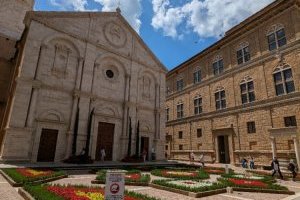
Pienza - a beautiful little town, where there weren't really many tourists. It was quiet there and when I looked at something for a longer time, no one pushed me. In my opinion, there is a Renaissance feel here more than in other Tuscan towns. Definitely don't miss sitting or at least standing for a while on the castle walls and looking at the countryside. There is a beautiful view of a piece of Tuscany and other towns on the hills. Then all you have to do is go somewhere for a good meal or at least a dessert. Suddenly you don't want to do anything, just stop and do nothing.
Keep reading 0 comments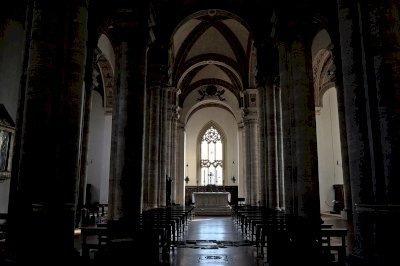
Having sworn off guided coach tours after a poor experience in Poland, I somehow had lapse in judgement and ended up booking myself on one from Rome up to Tuscany for the day. I thought, how bad could it be? In all honesty, not too bad at all although the day was clearly aimed at tourists looking to experience some Tuscan cuisine and culture rather than appreciate some Outstanding Universal Value and obsessively tick off another site on a somewhat arbitrary list. As such, we spent 1.5 hours in Montepulciano, which is a delightful village but tantalising just outside the core zone of Val d’Orcia, then 1.5 hours at lunch, which again was lovely although I would have liked larger portions, and finally just 30 minutes in Pienza itself. Admittedly, it is possible to see pretty much everything there is in Pienza in that time but I would like to have been a little less rushed.
Whilst the morning in Montepulciano had been too foggy to admire the view, from the terrace on the south side of Pienza by the afternoon the weather had cleared and there was a great view across the valley below with its iconic cypress trees and rolling hills. There is only one main road and you can walk across the whole town in no time at all but the all the little side alleys were a pleasure to explore, however briefly, with hidden tiny piazzas. On the main square, Palazzo Piccolomini is free to …
Keep reading 0 comments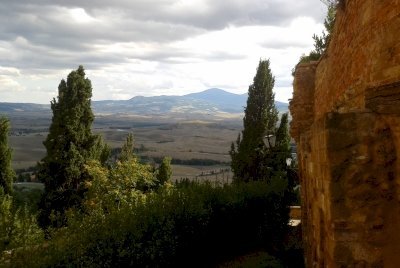
Pienza is pretty. Pienza is very little. Pienza is WHS with OUV that is rather philosophical, I would say. Pienza is located on a hill, so, there are beautiful views on the Orcia valley (another WHS) and towards Monte Amiata (photo), which is also worth-visiting: The Monte Amiata mountain is covered by thick beech and chestnut forest, and the open-air thermal baths can be visited in Bagni San Filippo at the foot of the mountain, and... freshly proposed TWHS Via Francigena crossed Monte Amiata in Abbadia San Salvatore! It is not necessary to say more about Pienza, all basic data is given already in other reviews. There is actually only one square (Piazza Pio II) and ca. 4 buildings (Cathedral, Palazzo Piccolomini, and several others palaces) that deserve attention. However, it is enough to make Pienza so special. Besides the architecture, food is also very delicate in Pienza.
Keep reading 0 comments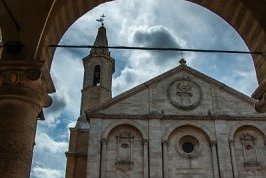
The historic center of the Pienza is inscribed on UNESCO List because it occupies a seminal position in the development of the concept of the planned “ideal town”, but you have to be a student of architectural history to fully appreciate that. For a relative dilettante, Pienza is simply a gorgeous postcard-size hill town, with no vehicular traffic on its narrow streets and dozens of picture-spot opportunities around every corner. Not too overrun by tourists either, probably on the account of being less famous than the likes of Siena or San Gimignano as well as sitting somewhat away from the beaten path.
Its size means that an hour or so is enough to cover the entire historic part of Pienza on foot. Piazza Pio II and Corso Rosselino are where most of the major architectural landmarks are situated, and there are a number of quaint little walkways and a terrace with sweeping views over Val d'Orcia. The cathedral is certainly worth stepping in; a visit to Palazzo Piccolomini as well as exploration of artisan shops can stretch the time in town to about half a day.
Since Val d'Orcia is a World Heritage site on its own merit, you should combine your visit to Pienza with a leisurely drive along SP146 towards San Quirico - or some other similar route - which offers many good viewpoints to appreciate the scenery for which the valley is renowned.
Keep reading 0 comments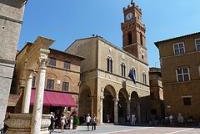
I visited this WHS in August 2013. Without Pienza there wouldn't have been Florence as we know it! It is the first Renaissance town and was used as a model for other towns and cities in Tuscany and Italy. The views over Val d'Orcia are worth taking in at sunset with a glass of wine. Via delle Case Nuove is interesting too and there is a very good organic gelateria named Buon Gusto which is the best in town!
Keep reading 0 comments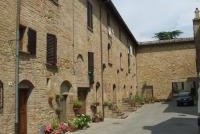
The monumental buildings surrounding the Piazza Pius II were certainly impressive, the white masonry of the duomo contrasting with the brown stone of the Piccolomini and Amouidi Palaces. But I found the newly restored houses on via della Casa Nuove equally interesting.
I reached Pienza by bus from Buonconvento station.
Keep reading 0 comments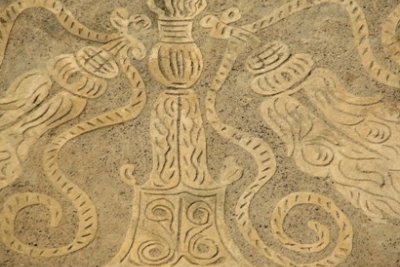
Pienza is a small but nevertheless pretty little town in the Tuscan hills. It has preserved its medieval center very well, it all comes across as very homogenous. The center is almost completely traffic-free, so it's a pleasure to walk in. An hour or 2 will be sufficient time to take in the main sights and roam around for a while.
I almost immediately found out that the place to be in Pienza is the walkway overlooking the Orcia Valley. Local old ladies and Japanese tourists alike enjoyed the combination of the warm sun on their faces and a great view over the Tuscan countryside. I quickly purchased a pannino con prosciutto at a nearby cafe and joined them - already that great feeling of being in a different world, just 4,5 hours after I left Amsterdam.
Dutifully I also had a look at the local sights. At the central square, quite small and strangely trapezoidal-shaped, I visited the interior of the Cathedral. And I joined a guided tour of the impressive Piccolomini Palace next door. It costs 7 EUR and is in Italian only, but worth going. Both Palace and Cathedral are virtual museums that hold major works of medieval art.
Keep reading 0 comments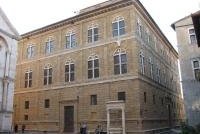
I have been once in the beautiful town of Pienza, constructed on the top of a hill surmounting the Orcia Valley, also listed as a WHS, between the Mount Amiata and the region of the Crete Senesi. It is an ideal Renaissance town, in which was transformed from 1459 under the Pope Pius II (Enea Silvio Piccolomini), that was born here when it was a medieval village called Corsignano; the Renaissance centre was projected following the theories of Leon Battista Alberti by his collaborator Bernardo Rossellino. On the beautiful trapezoidal Pius II’s Square, that is situated on a rock, the boundary of the town, and has a herringbone paving edged with travertine, overlook the most important buildings. The cathedral, projected by Rossellino with the influence of Alberti and made of travertine, has a Renaissance tripartite façade, divided by pillars and columns and decorated by the coat of arms of the family Piccolomini. The interior, divided in three aisles by clustered pillars from which spring the arches and the cross-vaults, was inspired by the Late Gothic German churches, that the Pope saw in his journeys around Europe. Inside there is a nice baptismal font and altars by Rossellino, Giovanni di Paolo, Vecchietta and Matteo di Giovanni. The Piccolomini Palace, constructed on the site of old houses owned by the family and constructed by Rossellino on the base of the Alberti’s Rucellai Palace in Florence, has three same three-storeyed façades, resting on a travertine plinth and divided by pilasters in three bands …
Keep reading 0 comments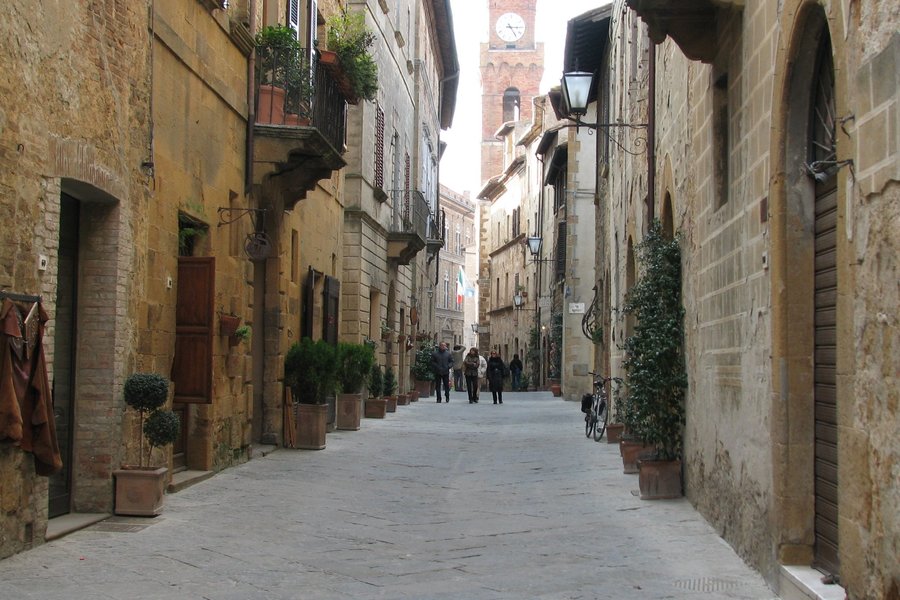
A lovely little town situated on the quinessentially Tuscan drive between Montalcino and Montepulciano. What the town lacks in notoriety in comparison to its famous neighbours, it makes up for in beauty and grace. Almost completely redesigned between 1459 and 1462 and renamed on the orders of hometown son Pope Pius II, the main square is the picture of Renaissance architecture, while the surrounding houses retain old village charm. A highly recommended lunch stop for those doing a tour of the vineyards of Southern Tuscany.
Keep reading 0 comments
